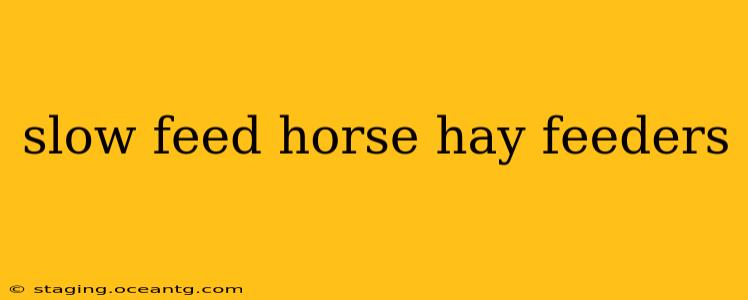Choosing the right hay feeder for your horse is crucial for their health and well-being. Slow feed hay feeders are designed to encourage slower eating, promoting better digestion and reducing the risk of various health problems associated with fast consumption, like colic and obesity. This comprehensive guide explores the benefits, types, and considerations when selecting a slow feed hay feeder for your equine companion.
What are the benefits of using a slow feed hay feeder?
Slow feeders offer numerous advantages for horses, significantly impacting their digestive health and overall well-being. By extending feeding time, they help prevent gorging, a common cause of colic. The slower eating rate also improves digestion, allowing the horse's system to process the hay more efficiently. This can lead to better nutrient absorption and a healthier gut microbiome. Furthermore, slow feeders can contribute to weight management, especially for horses prone to obesity. They promote natural grazing behavior, reducing boredom and encouraging a more relaxed eating experience.
What are the different types of slow feed hay nets and feeders?
The market offers a variety of slow feed hay feeders, each with unique designs and features. Here are some of the most popular types:
1. Hay Nets: These are perhaps the most common type. They come in various sizes and mesh sizes, allowing you to control the rate at which your horse consumes hay. Smaller mesh sizes and more complex designs generally slow down feeding more effectively.
2. Slow Feed Hay Bags: Similar to hay nets, these bags often feature multiple compartments or layers to further restrict hay access.
3. Puzzle Feeders: Designed to challenge your horse mentally and physically, these feeders require the horse to work for their food, further slowing down consumption. They often incorporate various compartments, tubes, or other obstacles.
4. Floor Feeders: These large, durable feeders sit on the ground, holding a substantial amount of hay. The design usually incorporates features that make it difficult for the horse to rapidly access all the hay at once.
5. Hanging Feeders: These feeders suspend from a fence post, tree, or other sturdy structure, keeping the hay off the ground and reducing waste. They often incorporate slow-feed features like smaller mesh or multiple compartments.
What size slow feed hay feeder should I choose?
Choosing the right size depends on several factors: your horse's size, breed, and eating habits, as well as the amount of hay your horse consumes daily. A larger horse will obviously need a larger feeder than a smaller one. Consider the type of hay you use—denser hay requires a feeder with larger openings or less restrictive design than lighter, fluffier hay. It's advisable to start with a feeder that's slightly smaller than what you think your horse needs and adjust as necessary. Always supervise your horse during their first few experiences with a new slow feeder to ensure a comfortable and safe feeding experience.
How do I introduce a slow feed hay feeder to my horse?
Introducing a slow feeder gradually minimizes stress and helps your horse adapt more easily. Start by offering a small amount of hay in the new feeder alongside their usual hay supply. Gradually increase the amount of hay in the slow feeder while decreasing the amount in their regular feed container over several days or weeks. This transition allows your horse to get accustomed to the new eating method without causing frustration or anxiety. Monitor your horse closely for any signs of stress or difficulty while using the slow feeder and adjust as needed.
How often should I refill a slow feed hay feeder?
The frequency of refilling depends on your horse's consumption rate and the size of the feeder. As a general guideline, aim to refill the feeder at least once daily, or more often if needed, to prevent your horse from running out of hay. Regular checks prevent the feeder from becoming completely empty, which could trigger anxiety or frustration. The specific refill schedule will be influenced by your horse's size, feeding habits, and the feeder's capacity.
Can I use a slow feed hay feeder for all horses?
While slow feeders are beneficial for many horses, there might be exceptions. Horses with certain dental issues or those recovering from illness may require modifications or alternative feeding strategies. Always consult with your veterinarian before introducing any new feeding method, especially if your horse has any underlying health concerns. They can assess your horse’s individual needs and ensure the feeding method is suitable.
Are slow feed hay feeders safe for horses?
When used appropriately, slow feed hay feeders are generally safe. However, always ensure the feeder is securely attached and made of durable, non-toxic materials. Regularly inspect the feeder for any damage or wear and tear. Choose feeders with designs that minimize the risk of entanglement or injury. Never leave a horse unattended with a new feeder until you are certain they understand how to use it safely and efficiently.
By carefully selecting and properly utilizing a slow feed hay feeder, you can significantly improve your horse's digestive health, overall well-being, and contribute to a happier, healthier equine companion.
